Down syndrome is a common genetic disorder that affects about 400,000 Americans. Each year, about 6,000 babies are born in the United States with Down syndrome, a disorder caused by abnormal cell division that results in an extra chromosome, specifically chromosome 21. The severity of the condition varies, depending on one’s Down syndrome karyotype, which is the organized profile of an individual’s chromosomes. The effects could include physical, developmental and intellectual abnormalities that affect children throughout life.
What Are the Karyotypes of Down Syndrome?
Each cell in the body normally contains 23 pairs of chromosomes. Chromosomes are thread-like structures that come in pairs, with each part coming from one parent. These chromosomes carry your DNA, or the genetic material that contains information which controls your growth, development, function and reproduction.
The organized profile of an individual’s chromosomes is known as a karyotype. It gives you a picture of how many chromosomes you have, as well as the structure of each chromosome. It also determines the sex of an individual and can help diagnose abnormal conditions such as the Down syndrome. The Down syndrome karyotype shows a total of 47 chromosomes instead of 46 (normally made up of 23 pairs of chromosomes).
Down syndrome occurs when cell division involving chromosome 21occurs abnormally, causing an extra chromosome to be produced. This leads to the development of characteristic features and problems of Down syndrome.
Types and Karyotypes of Down Syndrome
The karyotypes of Down syndrome involve any of the following 3 varieties:
- Trisomy 21: 95% of Down syndrome patients have a condition caused by trisomy 21, wherein
 the cell contains three (instead of two) replicas of the chromosome in all cells. It arises from abnormal cell division during the development of either the sperm or the egg.
the cell contains three (instead of two) replicas of the chromosome in all cells. It arises from abnormal cell division during the development of either the sperm or the egg. - Mosaic Down syndrome: This is a rare form, where only some cells have an extra chromosome 21. The presence of both normal and abnormal cells (mosaic) is due to abnormal cell division after the egg is fertilized by the sperm.
The image on the right shows chromosome 21 having three copies. In most affected patients, this karyotype is found in all cells (trisomy). In very few patients, only some cells contain extra chromosome 21, while others appear normal (mosaic form).
- Translocation Down syndrome: Sometimes a part of chromosome 21 is translocated, or becomes attached to another chromosome, before or during conception. This results in children having the usual pair of chromosome 21, but additional genetic material from chromosome 21 is attached to another chromosome.
The following image shows the Down syndrome karyotype of a patient with part of their chromosome 21 being translocated to another chromosome.
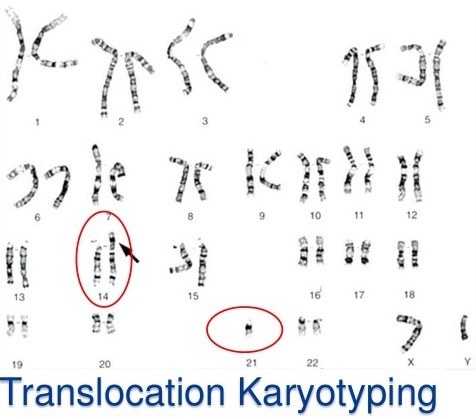
Characteristics of children with Down syndrome usually include:
- Decreased muscle tone ("floppy" babies)
- Small nose, flat facial features
- Eyes slanted upward
- Inner corner of eyes have small skin folds
- Small ears with abnormal shape
- Palms with single deep crease
- Hyper flexibility of joints
- Enlarged tongue
- Other problems include: learning disability, vision and hearing problems, cardiac and bowel defects, and thyroid problems
Watch the video to know what Down syndrome is, its risk factors, its symptoms, complications, testing methods and so much more:
Other Conditions with Abnormal Karyotypes
Besides Down syndrome karyotype, there are other genetic conditions that result from abnormal karyotypes. Here are some of them:
1. Klinefelter Syndrome
This genetic disorder affects males who are born with extra sex (X) chromosomes. Most of them grow up without any obvious symptoms, but others have scarce body hair, wide hips, enlarged breasts and small testicles and penis. They can have a normal sex life, but remain infertile.
The Klinefelter syndrome karyotype looks like this:
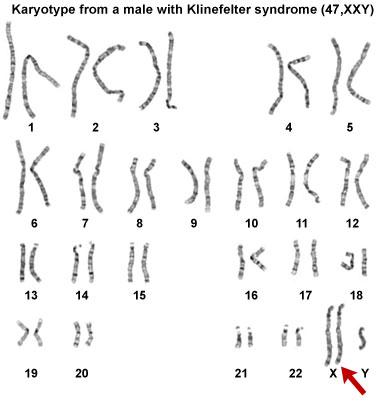
2. Edwards Syndrome
Edwards syndrome is also known as trisomy 18, because the baby has an extra chromosome 18 in all or some of their body cells. A few may also have translocated chromosomes. They are often born small and very frail, typically having many serious physical defects and health problems such as: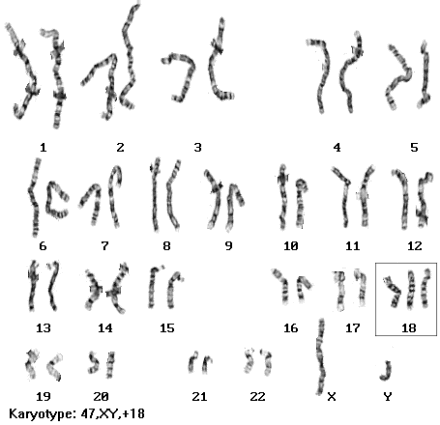
- Small head
- Small jaw
- Defects in the lungs, stomach/intestines and kidneys
- Cleft palate
- Deformed feet
- Clenched fists, overlapping fingers
- Feeding problems
- Low-set ears
- Heart defects
- Chest deformity
- Severe developmental delay
- Slowed growth
3. Patau Syndrome
Patau syndrome is also known as trisomy 13, because the baby has an extra chromosome 13 in all or some of their body cells. A few may also have translocated chromosomes. The extra chromosome disrupts their normal course of development, causing severe intellectual and physical abnormalities. These include weak muscle tone, heart defects, brain/spinal cord abnormalities, very small/poorly developed eyes, extra fingers/toes, a cleft lip, and a cleft palate. Most babies die within the first few days/weeks of life.
The Patau syndrome karyotype looks like this:
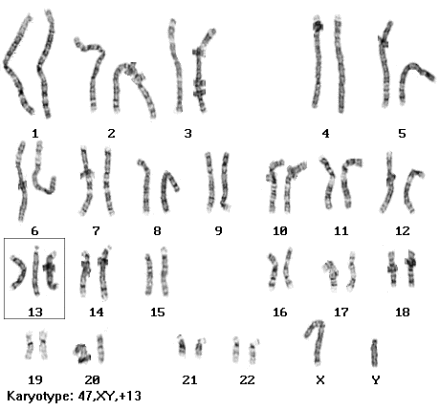
4. Turner Syndrome
Turner syndrome affects only females, resulting from a missing sex (X) chromosome. It is associated with various physical and developmental problems, including short stature, delayed puberty and infertility, heart defects, learning disabilities as well as problems in social adjustment.
Before birth, prenatal ultrasound may show: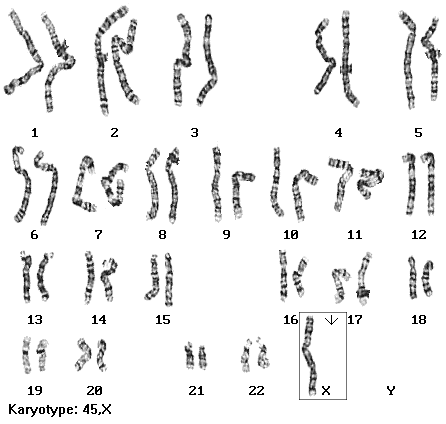
- Abnormal fluid collection
- Abnormal kidneys
- Heart abnormalities
At birth/infancy, signs of Turner syndrome may include:
- Wide/web-like neck
- Receding/small jaw
- Low-set ears
- High, narrow palate
- Broad chest, nipples widely set apart
- Short fingers/toes
- Swollen hands and feet at birth
- Smaller than average height
- Delayed growth
In some girls/women, signs and symptoms are not obvious. However, they may have no growth spurts as expected, resulting in short stature, learning disabilities, difficulty adjusting to social situations, delayed sexual changes during puberty secondary to ovarian failure, early end of menstrual cycles, and inability to conceive without fertility treatment.
